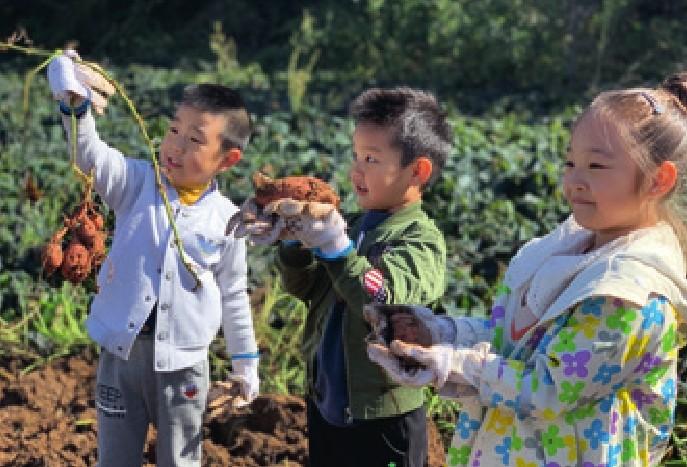In a Nutshell:Rural Vitalization
2022-03-14ByTaoXing
By Tao Xing
China unveiled its No.1 Central Document for 2022 on February 22, highlighting key tasks to comprehensively push forward rural vitalization this year. As the first policy statement released by the central authorities every year, the document is seen as an indicator of the nation’s strategic priorities.
Agriculture, rural areas and rural people have long been considered the cornerstones of China’s socioeconomic development. Starting from 2004, efforts to their benefit have featured high on the government’s agenda. The document called for efforts to stabilize and increase agricultural production, steadily raise rural incomes, and ensure stability in rural areas to cope with the COVID-19 pandemic and other changes unseen in a century, as well as promote sound economic and social development.
Having removed all impoverished counties from its poverty list, China has gradually shifted its policy focus from poverty alleviation toward comprehensively promoting rural vitalization. China’s countryside population on the mainland stood at 498.35 million as of 2021, representing 35.28 percent of the total populace, data from the National Bureau of Statistics (NBS) showed.
In a certain time, with the rapid advancement of industrialization and urbanization, the urbanrural income gap continued to widen as farmers’incomes had only risen slowly, according to Wang Jinxia, Director of the China Center for Agricultural Policy at Peking University.
However, in the recent decade, with the national poverty alleviation drive and further agricultural and rural reform and development, rural residents’ incomes have outpaced those of urban residents, resulting in a narrowing of their income gap, according to a government white paper titled China’s Epic Journey From Poverty to Prosperity, released in 2021.
“We should further consolidate and expand the achievements of poverty alleviation, improve poverty monitoring and assistance mechanisms to assure rural residents a better living environment and improved livelihood,” Wang told Beijing Review.
With over 1.4 billion people and limited arable land, it is not realistic for China to depend on the global market for its food security, hence the country must develop modern agriculture.
“We must firmly hold the bottom lines of guaranteeing China’s grain security and ensuring there will be no large-scale return to poverty,” the document noted. China will enhance grain production and the supply of vital agricultural products, the document read.
Grain security has always been a top priority in China’s agricultural undertakings. Given the consistently important status of food security, this year’s document mentioned it at the very beginning with special consideration, Jiang Wenlai, a researcher with the Chinese Academy of Agricultural Sciences, told China News Service.
In the context of the global COVID-19 spread, some countries have imposed certain restrictions on grain exports. Moreover, international grain prices have fluctuated violently and the global status quo is, to say the least, complex and changeable.
Today, China guarantees people’s grain supply to promote social stability, Jiang said.
New measures will warrant that the sown areas for grains remain stable and full-year grain output remains above 650 billion kg, the document read.
China’s output has exceeded 650 billion kg for seven consecutive years, Wang said, “It cannot go under this number in the future, given it marks the bottom line for grain security.”
The supply of staple grains, such as rice, wheat and corn basically has no issues, she added, but the problem lies in soybeans and oil crops. To cope with this kind of difficulty, the document listed detailed procedures for various areas to optimize their agricultural structure in accordance with the local conditions, so as to enhance the production capacity of soybean and oil plants. For examples, promoting the interplanting of corn and soybeans in the northwestern and southwestern regions, and carrying out grain and soybean rotation in the northeastern region.
In 2022, China aims to develop 6.67 million hectares of high-standard farmland, execute national projects on black soil protection, and launch the third nationwide soil condition census, noted the document.
It also specified measures to dynamically endorse research on vital agricultural core technologies such as germplasm, enhance applications of agriculture machinery and equipment, accelerate development of facility agriculture, and effectively prevent and respond to major agriculture-related disasters.
“We should guarantee grain security by protecting our soil and farmlands and strengthening the integration of agriculture and technology,” Wang concluded.“The purpose of rural vitalization is to realize common prosperity,” Wang said.
China published a guideline last June supporting the eastern province of Zhejiang to take the lead in establishing a demonstration zone for the promotion of common prosperity nationwide. The guideline also called on a narrowing of the urban-rural income gap, with precedence given to improving rural income. It intends to advance their wellbeing so that their living standards can match those of their urban counterparts.
“We will speed up the promotion of rural development,” Wang added.
In an interview with Xinhua, Minister of Agriculture and Rural Affairs Tang Renjian listed farm produce processing, rural tourism and rural ecommerce as three major industries for rural vitalization, and stressed the prevention of excessive financing, development and construction.
Efforts should go to developing county-level industries and commercial systems, as well as to encouraging rural residents to obtain employment or start businesses locally, read the document.

Xiu De Gu is a cultural tourism base located in Banbidian Village of Fangshan District in Beijing, where tourists can experience a touch of Chinese culture by, for example, studying the guqin, a plucked seven-string instrument, or dressing up in traditional Chinese costumes. The center can offer food and accommodation for 200 people simultaneously.
“The cultural tourism industry can help address village unemployment and improve local incomes,” Li Chengcheng, manager of the base, told Beijing Review.
The base now has around 40 employees, with 40 percent of them local villagers, she said, adding that it organizes local unemployed women to produce traditionally woven bracelets and sachets and sell these to tourists and outside buyers.
When business picks up during peak season, these women also take up additional part-time duties, such as teaching tourists how to weave their own bracelets, Li said. Furthermore, given the area is suitable for growing honeysuckle, we collect the flowers, retain the nectar and turn it into tea to increase added value.
“We will also begin developing urban and rural infrastructure and communities, and promote equal access to basic public services in urban and rural areas,” Wang added.
The No.1 document urged the continued implementation of the five-year action plan on improving the rural living environment, stressing solid work on enhancing rural infrastructure in key areas such as highways, water facilities, power grids and clean energy facilities, as well as improving housing quality.
It further called for greater efforts in digital village development by pushing for smart agriculture and empowering rural public services through digital technologies.
Wang also noted that such rural progress should head toward a greener path toward the country’s carbon peak and neutrality goals, set to be achieved before 2030 and 2060, respectively.“In developing agricultural production and rural development, we need to reduce pollution in all its forms.” she said. BR
3112500338200
